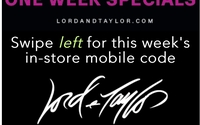 Mobile commerce is becoming increasingly complex, requiring the
coordination of more moving parts.
Mobile commerce is becoming increasingly complex, requiring the
coordination of more moving parts.
This can have some serious implications in terms of speed to market or, more likely, the speed of making a change once a commerce program is implemented.
Most notable are mobile activities becoming part of already established systems, which often involve people.
For example, when Lord & Taylor introduced its beaconing, it involved
installing beacons in stores, which triggered various in-store messages based on where a shopper is in the store.
In the early stages of such launches, getting the program off the ground is
paramount.
At first, this can mean just installing some beacons with the associated beacon platforms and testing what does and doesn’t resonate with customers.
But after that,
the people who work in the store need some insight about what’s going on so that when a customer asks about a message they received, for example, the sales associate at least understands the
question.
advertisement
advertisement
And now this is starting to happen.
Over the weekend, I visited a number of malls and retailers to check out some of the state of end-to-end mobile commerce.
At two
different Lord & Taylor stores in the Boston area, where I know there are beacons, I received a message via the Swirl app as I approached the store (the retailer uses the Swirl beacon
platform.)
Once inside, I got messaging from both the retailer and brands as I entered different departments.
Interestingly, the entire in-store ad campaign is new, replacing the
program that was in place at launch, as I wrote about here at the time (Lord &
Taylor, Hudson’s Bay Go Big on Beacons).
More interesting on this trip was that near beacons at both stores employees I spoke with were well aware of the in-store messaging.
Knowledge of mobile technology being deployed is now being incorporated with staff training.
The same is true with the beaconing program at the Marriott San Diego, where employees are
trained and knowledgeable about the beacons and the local perks they provide as guests pass certain areas in the hotel (Beacons Deliver Local Perks at Marriott).
In the area of mobile payments,
I’m also seeing more point-of-sale terminals now installed with chip-and-pin reading capabilities to accommodate the coming wave of credit cards with embedded chips, along with mobile payment
capability.
For example, grocer Wegmans recently installed new terminals overnight to accommodate both chip and pin and mobile payments. Others, like Bloomingdale’s and Macy’s,
also are becoming mobile payment hardware equipped.
As in many other similar commerce hardware upgrades, the technology is there but not yet activated. Next will be the employee training.
The point is that more of the pieces of the mobile commerce chain are being linked together, which is good news for consumers.
There also are smaller and peripheral components to consider,
which can take time to resolve.
For example, the mobile payments consortium of Verizon, AT&T and T-Mobile changed its unfortunate original name of Isis to Softcard at the beginning of last
month.
At a Coke machine totally equipped for mobile payments in a Boston mall, the screen shows how to make a payment, prominently featuring, you guessed it, the Isis mobile wallet, which no
doubt eventually will be updated.
Successful mobile commerce involves a lot more than just the technology.
At least more of the moving parts around it are
beginning to become part of the train.
_________________________________________
Check out the MediaPost conference on beacons, being held Nov. 3 in New York (IoT: Beacons).